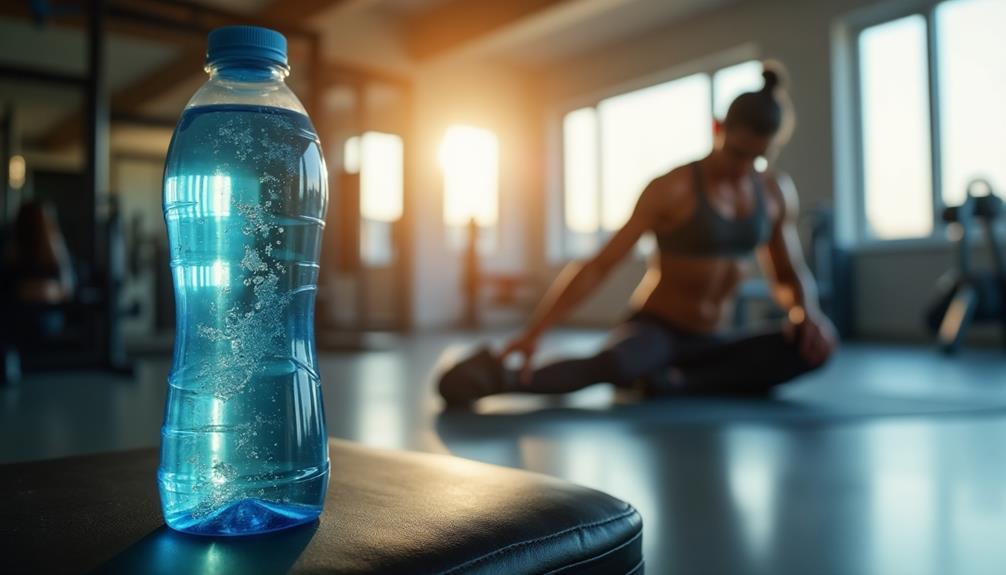To manage soreness after hypertrophy training, begin by staying hydrated; drink ample water and consider electrolyte gummies. Next, include active recovery like walking or gentle cycling to boost blood flow. Prioritize nutrition by consuming protein-packed meals along with well-rounded carbs and nutritious fats for energy. Foam rolling is also advantageous; it alleviates soreness, boosts blood flow, and enhances flexibility. Lastly, make sure you get quality sleep by establishing a routine and creating a cozy environment. These steps will not only assist in recovery but will also enhance your overall performance. More insights await you on optimizing your recovery strategies.
Core Insights
- Stay hydrated by drinking water regularly to help manage soreness and prevent dehydration.
- Incorporate low-intensity active recovery exercises, like walking or cycling, to reduce muscle stiffness.
- Prioritize protein-rich meals and include protein supplements to aid in muscle repair and recovery.
- Use foam rolling techniques post-workout and a few times a week to reduce soreness and improve flexibility.
- Ensure quality sleep by establishing a routine and creating a restful environment for optimal recovery.
Stay Hydrated

Staying hydrated is essential for managing soreness after hypertrophy training. Water plays a key role in muscle recovery by transporting nutrients and removing waste. When you exercise, you lose fluids through sweat, which can lead to dehydration. This, in turn, can worsen muscle soreness and delay recovery. Electrolyte gummies can be an effective way to replenish essential minerals lost during intense workouts, promoting better hydration and muscle function.
To stay hydrated, aim to drink water regularly throughout the day. A good rule of thumb is to consume about half your body weight in ounces. Additionally, consider drinking water before, during, and after your workouts. If you find plain water boring, try adding a splash of lemon or a few slices of cucumber for flavor. Remember, maintaining hydration is a simple yet effective strategy to support your recovery and reduce soreness.
Incorporate Active Recovery

Hydration sets the stage for recovery, but incorporating active recovery can further enhance your results after hypertrophy training. Active recovery involves low-intensity exercises that promote blood flow without straining your muscles. Consider activities like walking, cycling, or light swimming. These movements help reduce muscle stiffness and improve flexibility. Epsom salt baths can also be beneficial for muscle recovery, helping to reduce inflammation and promote relaxation after intense workouts.
Aim for 20 to 30 minutes of active recovery a few days a week. It's a great way to keep your body moving while allowing your muscles to recover. Listen to your body; if something feels too intense, dial it back. The goal is to facilitate recovery, not to push yourself harder. By adding active recovery to your routine, you'll feel fresher and perform better in your next hypertrophy session.
Prioritize Nutrition

- Protein Intake: Aim for a protein-rich meal post-workout. This helps repair muscle fibers and promotes growth. Incorporating isolate protein powders can be an efficient way to boost your protein intake, especially when whole food options are limited. These powders are quickly absorbed, making them ideal for post-workout nutrition.
- Hydrate: Drink plenty of water to aid in nutrient transport and to prevent dehydration, which can hinder recovery.
- Balanced Meals: Include carbohydrates and healthy fats to replenish glycogen stores and provide sustained energy.
Use Foam Rolling

Foam rolling is often an overlooked but effective method for managing soreness after hypertrophy training. This technique helps release muscle tightness, improve blood flow, and enhance recovery. By using a foam roller, you can target specific muscle groups that may be sore or tight after your workouts.
Benefits of Foam Rolling
| Benefits | How It Helps | Frequency |
|---|---|---|
| Reduces soreness | Increases blood flow | Post-workout |
| Improves flexibility | Enhances range of motion | 2-3 times/week |
| Aids recovery | Speeds up muscle repair | Daily if needed |
Incorporating foam rolling into your routine can lead to better performance and less soreness, allowing you to train harder and recover faster. So, give it a try!
Get Quality Sleep

- Establish a Routine: Go to bed and wake up at the same time each day to regulate your body's internal clock.
- Create a Sleep-Friendly Environment: Keep your bedroom cool, dark, and quiet. Use blackout curtains or a white noise machine if needed.
- Limit Screen Time: Avoid screens at least an hour before bed to reduce blue light exposure, which can interfere with your sleep cycle.
Prioritizing quality sleep will aid in reducing soreness and improving your overall performance.
Frequently Asked Questions
How Long Should I Wait Before Training the Same Muscle Group Again?
You should generally wait 48 to 72 hours before training the same muscle group again. This recovery time helps prevent overtraining, allowing your muscles to repair and grow stronger, optimizing your overall progress.
Are There Specific Stretches That Help Reduce Muscle Soreness?
Yes, specific stretches can help reduce muscle soreness. Try dynamic stretches before workouts and static stretches post-training. Incorporating yoga or foam rolling into your routine can also alleviate tightness and enhance recovery.
Can I Still Lift Weights if I'm Sore?
Sure, you can still lift weights if you're sore, but listen to your body. Consider lighter weights or focus on different muscle groups. It's all about balancing recovery and continuing your training journey effectively.
What Role Does Genetics Play in Muscle Soreness?
Genetics greatly influences your muscle soreness levels. Some people naturally recover faster due to factors like muscle fiber composition and pain sensitivity. Understanding your genetic background can help you manage your expectations and training approach effectively.
How Can I Tell if Soreness Is Normal or an Injury?
You're feeling that familiar ache, but is it just soreness or something more? If pain lingers, worsens, or feels sharp, it's wise to get it checked. Trust your instincts; they're often spot on.

